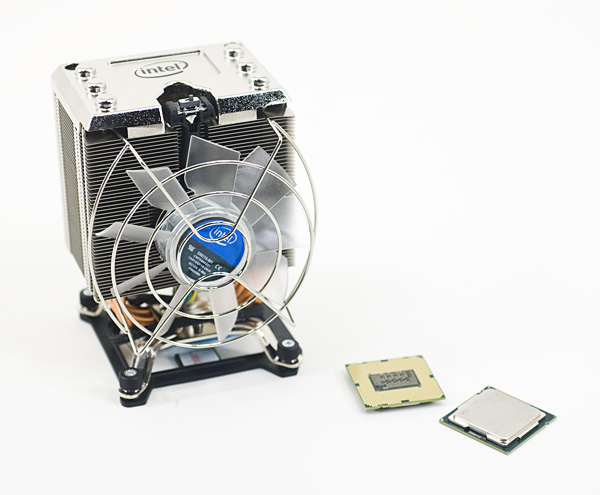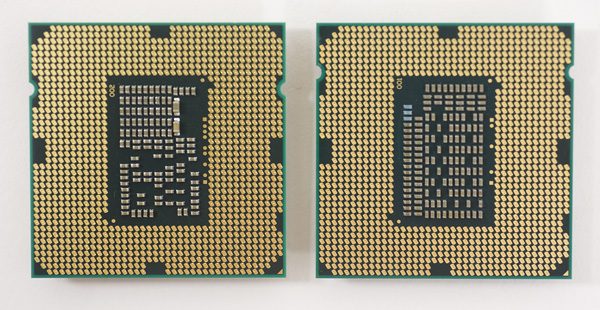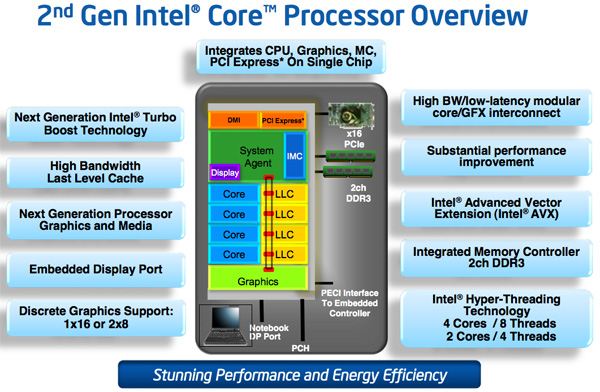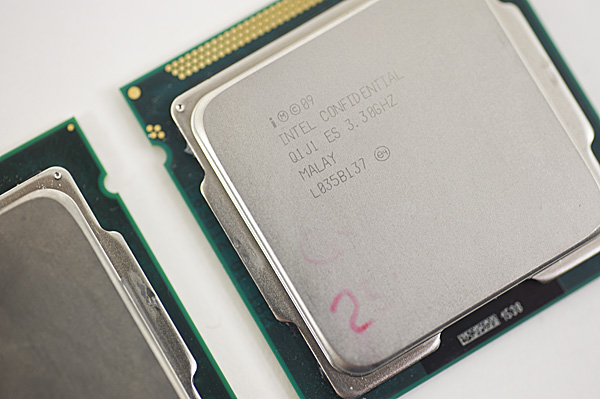The Sandy Bridge Review: Intel Core i7-2600K, i5-2500K and Core i3-2100 Tested
by Anand Lal Shimpi on January 3, 2011 12:01 AM ESTIntel never quite reached 4GHz with the Pentium 4. Despite being on a dedicated quest for gigahertz the company stopped short and the best we ever got was 3.8GHz. Within a year the clock (no pun intended) was reset and we were all running Core 2 Duos at under 3GHz. With each subsequent generation Intel inched those clock speeds higher, but preferred to gain performance through efficiency rather than frequency.
Today, Intel quietly finishes what it started nearly a decade ago. When running a single threaded application, the Core i7-2600K will power gate three of its four cores and turbo the fourth core as high as 3.8GHz. Even with two cores active, the 32nm chip can run them both up to 3.7GHz. The only thing keeping us from 4GHz is a lack of competition to be honest. Relying on single-click motherboard auto-overclocking alone, the 2600K is easily at 4.4GHz. For those of you who want more, 4.6-4.8GHz is within reason. All on air, without any exotic cooling.
Unlike Lynnfield, Sandy Bridge isn’t just about turbo (although Sandy Bridge’s turbo modes are quite awesome). Architecturally it’s the biggest change we’ve seen since Conroe, although looking at a high level block diagram you wouldn’t be able to tell. Architecture width hasn’t changed, but internally SNB features a complete redesign of the Out of Order execution engine, a more efficient front end (courtesy of the decoded µop cache) and a very high bandwidth ring bus. The L3 cache is also lower and the memory controller is much faster. I’ve gone through the architectural improvements in detail here. The end result is better performance all around. For the same money as you would’ve spent last year, you can expect anywhere from 10-50% more performance in existing applications and games from Sandy Bridge.
I mentioned Lynnfield because the performance mainstream quad-core segment hasn’t seen an update from Intel since its introduction in 2009. Sandy Bridge is here to fix that. The architecture will be available, at least initially, in both dual and quad-core flavors for mobile and desktop (our full look at mobile Sandy Bridge is here). By the end of the year we’ll have a six core version as well for the high-end desktop market, not to mention countless Xeon branded SKUs for servers.
The quad-core desktop Sandy Bridge die clocks in at 995 million transistors. We’ll have to wait for Ivy Bridge to break a billion in the mainstream. Encompassed within that transistor count are 114 million transistors dedicated to what Intel now calls Processor Graphics. Internally it’s referred to as the Gen 6.0 Processor Graphics Controller or GT for short. This is a DX10 graphics core that shares little in common with its predecessor. Like the SNB CPU architecture, the GT core architecture has been revamped and optimized to increase IPC. As we mentioned in our Sandy Bridge Preview article, Intel’s new integrated graphics is enough to make $40-$50 discrete GPUs redundant. For the first time since the i740, Intel is taking 3D graphics performance seriously.
| CPU Specification Comparison | ||||||||
| CPU | Manufacturing Process | Cores | Transistor Count | Die Size | ||||
| AMD Thuban 6C | 45nm | 6 | 904M | 346mm2 | ||||
| AMD Deneb 4C | 45nm | 4 | 758M | 258mm2 | ||||
| Intel Gulftown 6C | 32nm | 6 | 1.17B | 240mm2 | ||||
| Intel Nehalem/Bloomfield 4C | 45nm | 4 | 731M | 263mm2 | ||||
| Intel Sandy Bridge 4C | 32nm | 4 | 995M | 216mm2 | ||||
| Intel Lynnfield 4C | 45nm | 4 | 774M | 296mm2 | ||||
| Intel Clarkdale 2C | 32nm | 2 | 384M | 81mm2 | ||||
| Intel Sandy Bridge 2C (GT1) | 32nm | 2 | 504M | 131mm2 | ||||
| Intel Sandy Bridge 2C (GT2) | 32nm | 2 | 624M | 149mm2 | ||||
It’s not all about hardware either. Game testing and driver validation actually has real money behind it at Intel. We’ll see how this progresses over time, but graphics at Intel today very different than it has ever been.
Despite the heavy spending on an on-die GPU, the focus of Sandy Bridge is still improving CPU performance: each core requires 55 million transistors. A complete quad-core Sandy Bridge die measures 216mm2, only 2mm2 larger than the old Core 2 Quad 9000 series (but much, much faster).
As a concession to advancements in GPU computing rather than build SNB’s GPU into a general purpose compute monster Intel outfitted the chip with a small amount of fixed function hardware to enable hardware video transcoding. The marketing folks at Intel call this Quick Sync technology. And for the first time I’ll say that the marketing name doesn’t do the technology justice: Quick Sync puts all previous attempts at GPU accelerated video transcoding to shame. It’s that fast.
There’s also the overclocking controversy. Sandy Bridge is all about integration and thus the clock generator has been moved off of the motherboard and on to the chipset, where its frequency is almost completely locked. BCLK overclocking is dead. Thankfully for some of the chips we care about, Intel will offer fully unlocked versions for the enthusiast community. And these are likely the ones you’ll want to buy. Here’s a preview of what’s to come:
The lower end chips are fully locked. We had difficulty recommending most of the Clarkdale lineup and I wouldn’t be surprised if we have that same problem going forward at the very low-end of the SNB family. AMD will be free to compete for marketshare down there just as it is today.
With the CPU comes a new platform as well. In order to maintain its healthy profit margins Intel breaks backwards compatibility (and thus avoids validation) with existing LGA-1156 motherboards, Sandy Bridge requires a new LGA-1155 motherboard equipped with a 6-series chipset. You can re-use your old heatsinks however.

Clarkdale (left) vs. Sandy Bridge (right)
The new chipset brings 6Gbps SATA support (2 ports) but still no native USB 3.0. That’ll be a 2012 thing it seems.













283 Comments
View All Comments
Exodite - Monday, January 3, 2011 - link
I'm of two minds about that really.I had really set my mind on the 2500K as it offers unparalleled bang-for-buck and real-world testing have shown that Hyper-threading makes little difference in games.
With the compile tests it's clear there's a distinct benefit to going with the 2600K for me though, which means this'll end up more expensive than I had planned! :)
Lazlo Panaflex - Monday, January 3, 2011 - link
FYI, the 1100T is missing from several of the gaming benchmarks.....Melted Rabbit - Monday, January 3, 2011 - link
It wouldn't surprise me if that was intentional. I would hope that Anandtech reviewers were not letting companies dictate how their products were to be reviewed lest AT be denied future prerelease hardware. I can't tell from where I sit and there appears to be no denial that stating there is no such interference.In addition, real world benchmarks aside from games looks to be absent. Seriously, I don't use my computer for offline 3D rendering and I suspect that very few other readers do to any significant degree.
Also, isn't SYSMark 2007 a broken, misleading benchmark? It was compiled on Intel's compiler, you know the broken one that degrades performance on AMD and VIA processors unnecessarily. Also there is this bit that Intel has to include with its comparisons that use BAPco(Intel) benchmarks that include Intel's processors with comparisons to AMD or VIA processors:
Software and workloads used in performance tests may have been optimized for performance only on Intel microprocessors. Performance tests, such as SYSmark and MobileMark, are measured using specific computer systems, components, software, operations and functions. Any change to any of those factors may cause the results to vary. You should consult other information and performance tests to assist you in fully evaluating your contemplated purchase, including the performance of that product when combined with other products.
It isn't perfect, but that is what the FTC and Intel agreed to, and until new benchmarks are released by BAPco that do not inflict poor performance on non-Intel processors, the results are not reliable. I don't see any problem if the graph did not contain AMD processors, but that isn't what we have here. If you are curious, for better or for worse, BAPco is a non-profit organization controlled by Intel.
Anand Lal Shimpi - Monday, January 3, 2011 - link
Hardware vendors have no input into how we test, nor do they stipulate that we must test a certain way in order to receive future pre-release hardware. I should also add that should a vendor "cut us off" (it has happened in the past), we have many ways around getting supplied by them directly. In many cases, we'd actually be able to bring you content sooner as we wouldn't be held by NDAs but it just makes things messier overall.Either way, see my response above for why the 1100T is absent from some tests. It's the same reason that the Core i7 950 is absent from some tests, maintaining Bench and adding a bunch of new benchmarks meant that not every test is fully populated with every configuration.
As far as your request for more real world benchmarks, we include a lot of video encoding, file compression/decompression, 3D rendering and even now a compiler test. But I'm always looking for more, if there's a test out there you'd like included let me know! Users kept on asking for compiler benchmarks which is how the VS2008 test got in there, the same applies to other types of tests.
Take care,
Anand
Melted Rabbit - Tuesday, January 4, 2011 - link
Thanks for replying to my comment. I was understand why the review was missing some benchmarks for processors like the 1100T. I was also a bit hasty in my accusations with respect to interference from manufacturers, which I apologize for.I still have trouble with including benchmarks compiled on the Intel compiler without a warning or explanation of what they mean. It really isn't a benchmark with meaningful results if the 1100T is used x87 code and the Core i7-2600K used SSE2/SSE3 code. I would have no problem with reporting results for benchmarks compiled with Intel's defective compiler, like SYSmark 2007 and Cinebench R10 assuming they did not include results for AMD or VIA processors along with an explanation of why they were not applicable to AMD and VIA processors. However, not giving context to such results I find problematic.
DanNeely - Monday, January 3, 2011 - link
Sysmark2k7 is like the various 3dmark benches. Mostly useless but with a large enough fanbase that running it is less hassle than dealing with all the whining fanboi's/Anand Lal Shimpi - Monday, January 3, 2011 - link
There are a few holes in the data we produce for Bench, I hope to fill them after I get back from CES next week :) You'll notice there are some cases where there's some Intel hardware missing from benchmarks as well (e.g. Civ V).Take care,
Anand
Lazlo Panaflex - Monday, January 3, 2011 - link
Thanks Anand :-)MeSh1 - Monday, January 3, 2011 - link
Seems Intel did everything right for these to fit snuggly into next gen macs. Everthing nicely integrated into one chip and the encode/trascode speed boost is icing on the cake (If supported of course) being that Apple is content focused. Nice addition if youre a mac user.Doormat - Monday, January 3, 2011 - link
Except for the whole thing about not knowing if the GPU is going to support OpenCL. I've heard Intel is writing OpenCL drivers for possibly a GPU/CPU hybrid, or utilizing the new AVX instructions for CPU-only OpenCL.Other than that, the AT mobile SNB review included a last-gen Apple MBP 13" and the HD3000 graphics could keep up with the Nvidia 320M - it was equal to or ahead in low-detail settings and equal or slightly behind in medium detail settings. Considering Nvidia isn't going to rev the 320M again, Apple may as well switch over to the HD3000 now and then when Ivy Bridge hits next year, hopefully Intel can deliver a 50% perf gain in hardware alone from going to 18 EUs (and maybe their driver team can kick in some performance there too).